
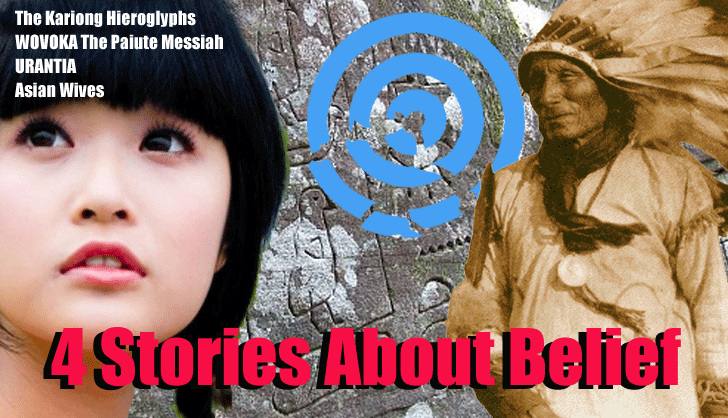
I'm going to tell you four stories that have something in common. They are all about believing. I don't want to say more about that now. I'm hoping that you will understand something amazing after you read all four of them.
#1 Egyptians in Australia: The Kariong Glyphs
The first story is about ancient Egyptians who visited the rocky coastline near Sydney, Australia about 4,500 years ago. According to the story, a shipwreck stranded two princely sons of Khufu, the 4th Dynasty ruler who built the Great Pyramid. They had come to Australia on one of many expeditions to share in and learn from the rich spiritual heritage of the Original people. The Aborigines taught the Egyptians religious concepts and, among other things, the writing system we have come to call hieroglyphics.
One of the princely brothers got bitten twice by a poisonous snake and died. He was buried at the site and a collection of hieroglyphs, so they say, reveals this very story.
It sounds pretty incredible, doesn't it?
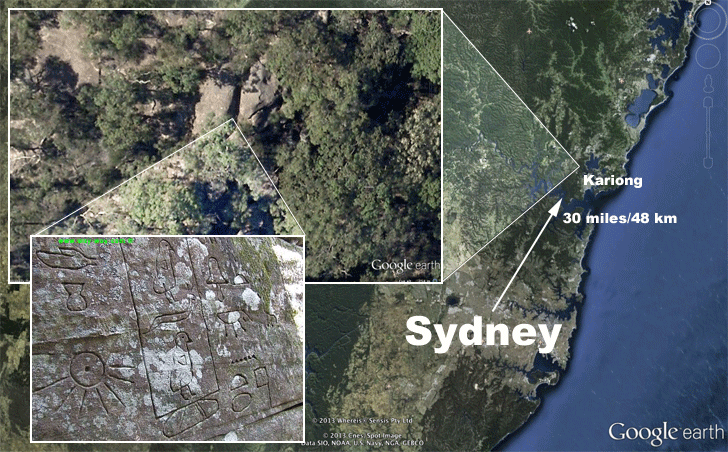
33°27'04.14"S / 151°18'09.50"E
Many believers of this story claim that the evidence is on two sandstone walls -- in a crevice -- on a privately owned bit of wilderness called Kariong, hence the Kariong Glyphs. This collection of hieroglyphs was first brought to public attention in the late 70s and has since evolved as a kind of Mecca for spiritualists, Aboriginals, new age thinkers and even UFO enthusiasts.
The site is located just 30 miles (48 km.) north of Sydney [map above] and is easily accessible by well maintained dirt roads that lead to within yards of the site. There are, so far, no gates or fences or fees. It couldn't be more convenient.
Below is a brief YouTube tour of the Kariong site by pilgrim, Guy Carter. He's obviously a believer in the authenticity of the hieroglyphs so be forewarned. The video is pretty good and gives you an idea of what you would see if you went there.
One might think that it would be easy to dismiss this as a hoax. The true age of the carvings should be sufficient... and then there are the glyphs themselves. Are they real Egyptian or just a collection of hieroglyphs from an encyclopedia? These things should be simple to determine, right? Wrong.
Belief in the authenticity of the Kariong Glyphs has persisted for almost 35 years and has endured the scrutiny and sarcastic criticism by historians, geologists and Egyptologists. Recently, with the threat of commercial development of the land, the Kariong Glyphs phenomenon has become entwined with environmental groups that seek the preservation of wild lands. They cite endangered species and the likely devastation of a unique environment that may never recover. To them, the presence of Aboriginal and Egyptian glyphs only strengthens their cause and brings added support for their own agenda.
Then there are the spiritualists, who believe the site is a focus of spiritual energy, a special zone where the soul can recharge itself, a medicinal and healing place. The video below will give you an example of this:
Obviously, one must be careful when asking questions about authenticity of the Kariong Glyphs. There is a lot more at stake here than just some petroglyphs.
So how old are the Kariong glyphs?
We can not judge the age of petroglyphs by their appearance. Weathering softens stone and makes it crack and crumble. But sometimes these effects are mitigated by their location. Carved shapes in a dry cave will outlast those on an exposed exterior wall which are subject to UV rays, temperature variance and dampness. It's all relative and the best archaeologists can do with a visual inspection is to guess.
Carbon-14 dating, which measures the traces of carbon-14 in once living material, is no good for testing the age of stone. In stratified excavations, finding a stone tool next to a piece of charcoal allows the latter to be C-14 dated and, by association, the stone tool. The assumption is that they were both deposited in the layer of debris at around the same time. But for vertical archaeology, like petroglyphs on walls, no association is possible.
In the case of the Kariong Glyphs, there are some well known examples of Aboriginal petroglyphs on the floor of a rocky creek, also sandstone, in close proximity to the hieroglyphs. These are believed to be 250 years old and show much more weathering than the hieroglyphs which are alleged to be 4,000 years older. That fact could be evidence that the hieroglyphs are a hoax.. but wait. Not so fast.
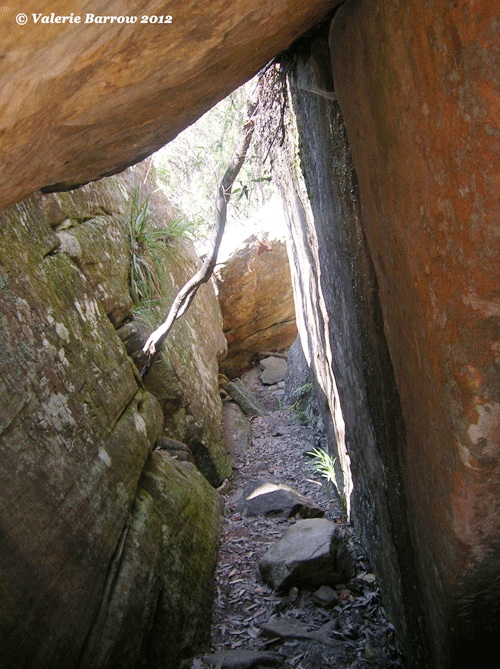
According to reliable sources, there was some construction on the site at Kariong in the 80s. A bulldozer was clearing wood and stones and is alleged to have driven over the top of the stony crevice where the hieroglyphs are located. It cracked several large and flat stones that were covering the crevice and acting as a roof. In fact, these stones can be still be seen today in photographs [above].
It's a stretch, but just maybe the crevice was once more like that "dry cave" we spoke about earlier. Maybe it did preserve the writing. Maybe we will never know the age of the hieroglyphs by just looking at them. So what's next?
When did people first notice the Kariong Glyphs?
People who lived near the site were surprised to learn that it contained anything. The rocky crevice was unremarkable prior to being cleared and before the roof was broken open.
The first person to make note of the petroglyphs was Alan Dash, a government surveyor who was mapping the area in the early 1970s. He noticed a man emerging from the rocks and walking to the abandoned house on the site, once belonging to the Gilford family but then being host to transients.
Dash acknowledges the cave like condition at the site by referring to the crevice as a "hole". He notes that, upon entering the hole, he saw hieroglyphic characters on the west wall but not on the east wall.
Six month's later, Dash returned with a co-worker and noticed that the eastern wall was now covered with hieroglyphics. Then, a year after that, he brought a group of people to see the site and discovered a second group of hieroglyphs, outside and about 120 feet from the crevice. These hieroglyphs were smaller and more crudely drawn. [source]
Dash's testimony seems to describe a more recent timeline for carving the glyphs. His story is often refuted by stating that the crevice was filled with debris which would have prevented him from seeing the east wall. The interior had been cleaned out before his second visit to the site, revealing the hieroglyphs that were always there. The second group (outside) were always there but only recently got noticed when a group of people were roaming around the site, scouring every rock and stone for petroglyphs.
Then there is this old report which I have made available in pdf format (about 400k). It's titled, Records of the Rock Engravings of the Sydney District Nos. 146-162 and is dated November 1966. The survey covers virtually all of the known carvings and petroglyphs in the immediate area of the Kariong Glyphs -- including some remarkable figures [below] which have been interpreted as Aboriginal star charts. But the report makes no mention of either the hieroglyphs in the crevice or the second, smaller group discovered on an outside wall.
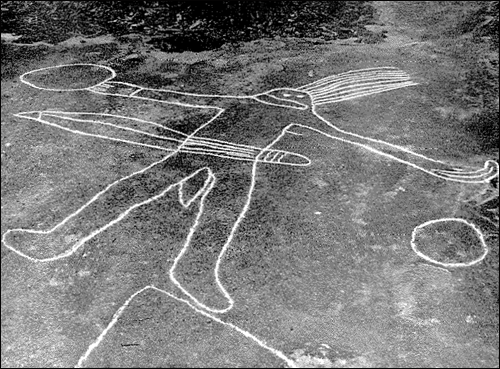
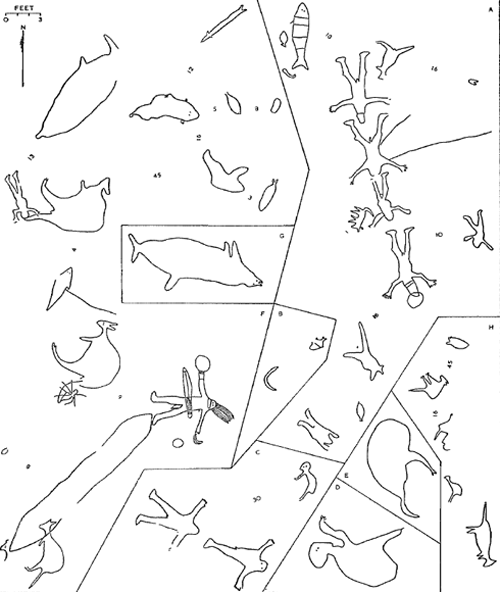
Aboriginal art abounds in the area where the hieroglyphs were found.
It's highly unlikely that the survey would miss the hieroglyphs if they were really there. But it is possible. Forgetting about the written records, what about the oral traditions of the Original people who inhabited this land? What do they say about this?
What do the Aboriginal People say about these glyphs?
Here is where the story gets difficult.
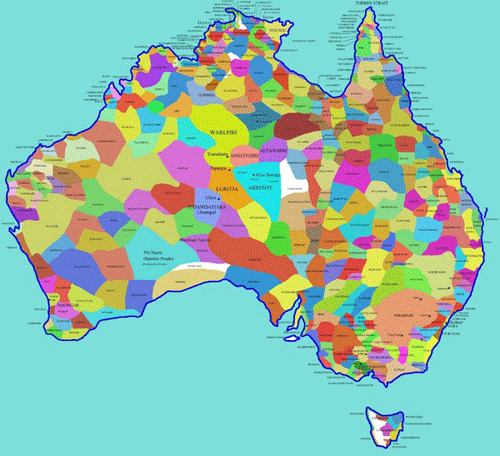
Above is a map showing the various languages and clans of the Australian continent. Each local group maintains the history and tradition which is passed from each generation by the "elders" -- those who have been initiated. Aboroginal people are not scriptural. Instead they have stories that are recited and memorized, sometimes accompanied by carvings or colorful pictograms.
The area where the hieroglyphs is located was part of the geographic region that suffered from a devastating smallpox epidemic, so the indigenous caretakers of that region suffered the loss of their culture along with their lives. But the story was apparently perpetuated in the oral traditions of surrounding clans, according to Darkinjung Elder, "Auntie Beve".
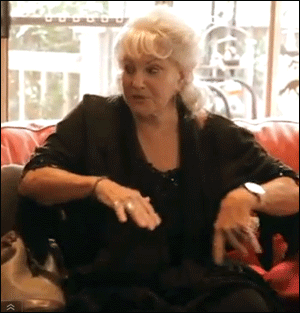 Aunty Beve Spiers claims to be an initiate who was given some stories to memorize when she was young. She remembers being told that she would be asked to recite these for some people in the future. She recalls a story she was told about two men from Egypt who visited the area in antiquity. She was told of contact between the Aboriginal People and other global cultures and acknowledges that the Kariong Glyphs were made by Egyptians long ago [source].
Aunty Beve Spiers claims to be an initiate who was given some stories to memorize when she was young. She remembers being told that she would be asked to recite these for some people in the future. She recalls a story she was told about two men from Egypt who visited the area in antiquity. She was told of contact between the Aboriginal People and other global cultures and acknowledges that the Kariong Glyphs were made by Egyptians long ago [source].
Auntie Beve probably does not fit your traditional idea of an Aboriginal woman. In fact, she did not even acknowledge her ancestry until she was 47 years old. Although her childhood seemed to be associated with the old ways, she spent her adult life successfully fitting in with the White culture. This is sill evident with her blonde hair and jewelry.
She revealed these facts in a taped interview [source] with Steve Strong, the current "voice" for the Kariong Glyphs and spokesperson for Aborigines in many surrounding tribes.
When I asked him if he spoke for Aunty Beve, he replied:
Yes Aunty Beve shares heaps with me but I'm not only talking with and on behalf Aunty Beve. Throw in Original Elders like Gerry Bostock (Bundjalung), Walangari (Pitjanjatjara), Toulli (Torres Strait-kadaitja man), Auinty Minnie Mace (Woka Woka), Karnot Walker (Ramindjeri), David Fitzgerald (blood relation to Pemulwuy), Lewis Walker (Bundjalung), Kerrianne Cox (Kimberley WA), etc."
--E-Mail to viewzone 2/4/13
Although it was Steve Strong who sparked our interest in this phenomenon, we decided to focus our attention on the authenticity of the hieroglyphs and not get sidetracked with Steve's other related theories. These involve UFOs, Pleiadians, Thoth and much more -- all built upon the authenticity of the Kariong Glyphs.
Steve has a series of four YouTube videos taken of the hieroglyphs with a hi-def camera. He explains his interpretations and ideas with enthusiasm and candor. The camera likes him. His skills as a communicator are revealed in the many interviews he has done.
Well, you might as well watch a bit of the original and you will see what I mean:
Let us continue. We need to know what the hieroglyphs say. I mean if it translates to something like "For a good time, see Chloe" then it's a bust.
Next -- What do the hieroglyphs say?

